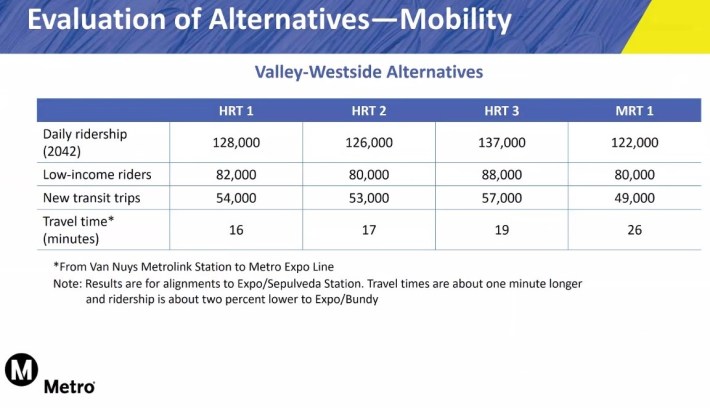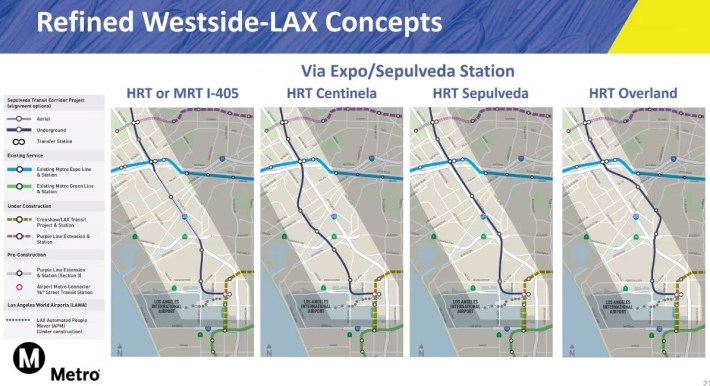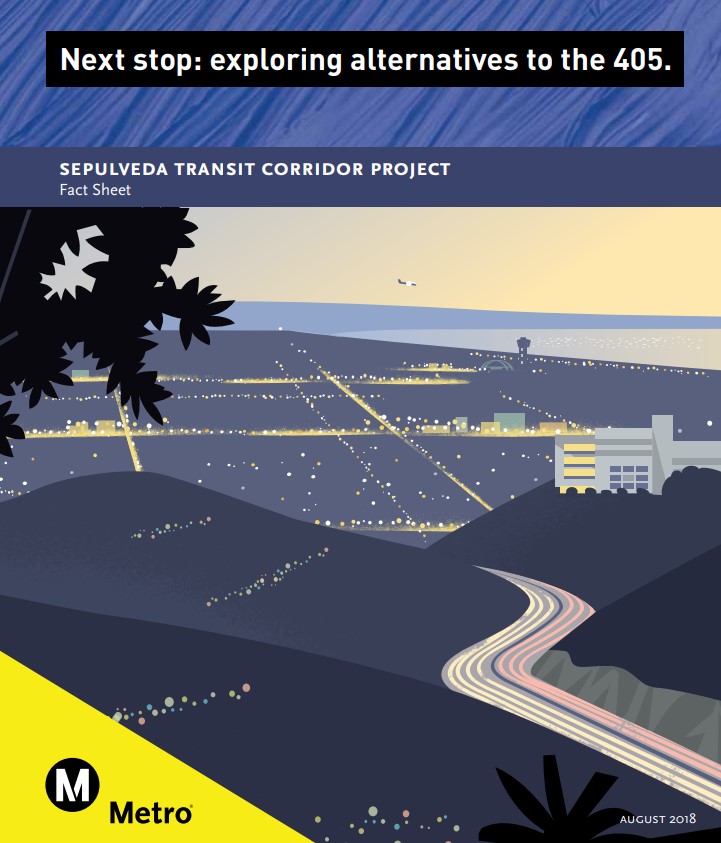Metro is continuing to refine plans for its Sepulveda Transit Corridor Project, which will connect the Valley to the Westside. The plan is to create a transit corridor that roughly parallels the 405 Freeway. The Sepulveda line is anticipated to be heavy rail (HRT), though Metro is still studying the possibility of a monorail.

The Sepulveda project consists of two phases:
- North: Extending from Westwood to Van Nuys. This ~12-15 mile section would connect to the existing Metro Expo Line, Orange Line, and Van Nuys Metrolink/Amtrak station - as well as to the future under-construction Westwood Purple Line station and planned Van Nuys light rail line - both of which would be completed before Sepulveda. Measure M schedules the north section to open 2033.
- South: Extending from LAX to Westwood. This ~6 mile section would connect to the Expo Line and under-construction Crenshaw/LAX light rail. Measure M schedules the south section to break ground in 2048.
Starting tomorrow night, Metro will host a series of community input meetings on the Sepulveda project. For meeting details, see SBLA calendar or Metro project webpage. Streetsblog L.A. got a preview of some of the new project information to be presented and discussed at these meetings.
(Also this week, the Metro board will vote on initiating a Project Development Agreement (PDA) to lay the groundwork for a possible public-private partnership (P3) arrangement that could design, build, operate, and maintain the Sepulveda line. The PDA would not fully commit Metro to P3, but would make P3 project delivery easier.)
Costs
Measure M provides the lion's share of funding for the project. Based on the 2015 preliminary cost estimate, Measure M includes $5.7 billion for the initial North section. That 2015 allocation is adjusted upwards over time, so today it is about $6 billion. The project is the most expensive component of Metro's planned 28-by-2028 Olympics project acceleration. Now estimated at about $10 billion, Sepulveda accounts for roughly forty percent of the estimated $25 billion capital outlay needed for proposed acceleration.
That early estimate assumed less tunneling than is currently anticipated, especially at the north end of the line that preliminary plans had ending at the Metro Orange Line.

Earlier this year, Metro's preliminary cost estimate for the Sepulveda line was ~$8.6 billion. With further technical refinement, this amount has escalated to $10-$14 billion. Partially-elevated alignments - HRT3 and monorail - come in slightly cheaper than the other two, which are all tunnel.
Travel Time and Ridership
Metro has new estimates for travel times and ridership on the Sepulveda line.

Metro estimates that ridership would be slightly higher for HRT2 and HRT3 alignments, which include an addition Valley station at Sherman Way. Travel time is shortest for the more direct HRT1, which would take only sixteen minutes to get from Van Nuys Metrolink Station to the Expo Line. The monorail alignment would run slowest, as it takes a less direct aerial route over the Sepulveda Pass.
Metro estimates that the new UCLA Station would have 17,000-18,000 daily boardings - the highest of any non-transfer station in the Metro system.
Alignments
For the north section, Metro's alignments (at top of post) are nearly the same as what the agency announced in January. The only minor change is that Metro is studying a possible additional Santa Monica Boulevard station between Wilshire and Exposition.
There is plenty of new analysis on possible alignments for the southern section.


The southern section alignments for the Sepulveda line would run more or less beneath Bundy Drive/Centinela Avenue, the 405 Freeway, Sepulveda Boulevard, or Overland Avenue. Plans for this section are less fully developed than for the northern section.
Unfortunately several of the alignments under consideration include mid-freeway stations. Metro's existing freeway stations are hellish for riders. Pretty much all of them regularly violate Metro's standards for station noise. In addition, some existing Metro freeway rail has been plagued by vehicles crashing into rail infrastructure. These stations also subject riders to freeway pollution, and freeway-adjacent access that is nearly always uncomfortable and dangerous for walking. Improving freeway stations has been difficult due to working with Caltrans.
The northern section potentially includes freeway-adjacent stations along the 405 at Ventura Boulevard, Sepulveda Orange Line Station, and Sherman Way; at this stage all of these would be close by (just east of) the 405, but not in the center of it. Preliminary southern alignments show 405 Freeway-adjacent stations at Venice Boulevard and Sepulveda/Slauson/Jefferson.

When questioned about issues with freeway stations, Metro staff shared the above Sepulveda/Ventura rendering suggesting that station design could help mitigate some of the negative aspects.

Travel time from the Van Nuys Metrolink Station to LAX is estimated to be 30-38 minutes.
Metro shared potential locations for a maintenance yard (MSF - Maintenance Service Facility.)

Learn more about Metro's Sepulveda Transit Corridor Project at this week's meetings.







